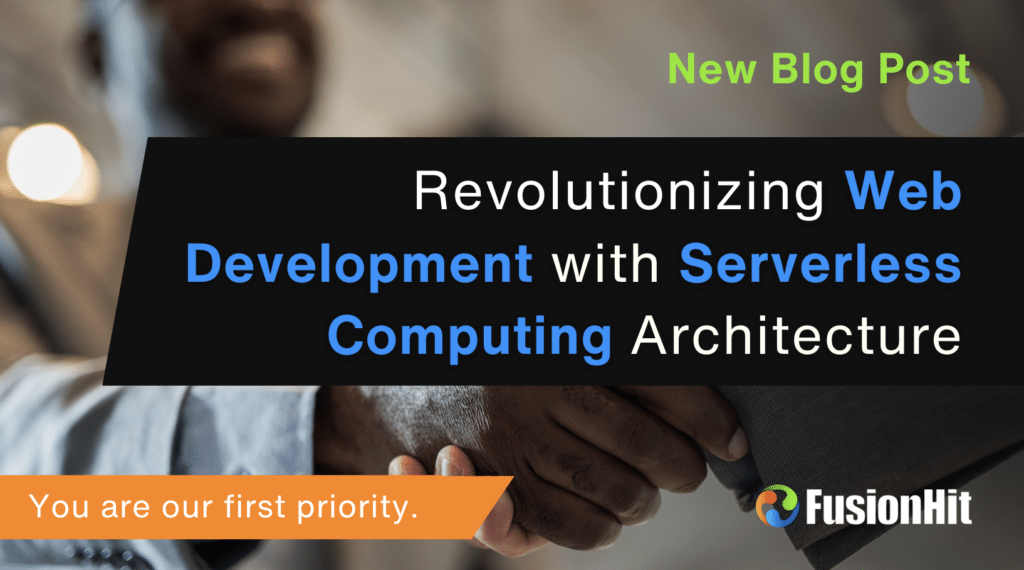
According to a study by Mordor Intelligence, the serverless computing industry is projected to grow by 23% from 2021 to 2026. Many tech enthusiasts believe that serverless computing will revolutionize computing models. Despite being introduced in 2006, it is only recently that every cloud provider has embraced this relatively new concept.
This blog will introduce serverless computing, including its advantages and disadvantages, to help you make an informed decision about transitioning to this new computing model.
Introduction to Serverless Computing
Serverless, FaaS, or Functions as a Service refers to a paradigm for creating and executing applications in the cloud that does not need the creation or management of servers or other backend infrastructure. With serverless architectures, programmers can devote their attention to creating polished front-end applications and robust business logic. The cloud service provider manages the containers where the application code will be stored.
The cloud service provider takes care of the rest, including setting up the necessary cloud resources to execute the code and expanding or contracting those resources as needed. It manages and maintains the infrastructure as a whole, including applying any necessary updates or patches to the underlying operating system, ensuring the system is secure, and determining how many resources will be needed.
Upsides of Going Serverless
With its many benefits, serverless computing has quickly become a popular choice among developers in the cloud computing industry.
- Cost-Effectiveness
The low price tag is one of the main reasons serverless computing is gaining popularity. If developers run their code on a serverless computing platform, they will only be charged for the time it runs. This contrasts with the conventional computing approach, where money and resources are typically wasted on unused virtual machines (VMs).
- Deployment in Minutes
Serverless computing greatly simplifies deployment. In contrast to the weeks or months often needed by traditional methods, this speedy rollout shortens the time it takes to meet customer needs and adapt to emerging market trends.
- Autoscaling
The capacity to autonomously scale resources is the key strength of serverless systems. Cloud service providers face the challenge of dynamically increasing or decreasing capacity depending on user demand, maximizing performance and efficiency. Without continually monitoring and alerting infrastructure, developers are free to concentrate on creating code.
- Increased Developer Productivity
With serverless computing, programmers don’t have to worry about maintaining servers or running times. Therefore, they can focus their efforts on creating and improving apps. This efficiency allows for more rapid innovation and better software execution.
Drawbacks of Serverless Computing
While serverless has many advantages, as a software outsourcing company, it is important to know its constraints to ensure a smooth transition.
- Supplier Monopoly
The possibility of being locked into a single vendor is a major downside. Serverless services are available from many cloud providers, but migrating between them might be difficult. Migration is difficult and time-consuming since various suppliers supply serverless services differently.
- Long-Running App Performance Issues
There may be better options than serverless for always-on apps, but it’s great for brief, event-driven jobs. It can become expensive to run lengthy operations in a serverless environment due to the pay-as-you-go pricing mechanism. Conventional virtual machines (VMs) or dedicated servers may be less expensive.
- Trouble With Latency
One potential issue with serverless architectures is latency. Invoking a serverless function might result in a pause known as a “cold start.” The platform initializes the environment for a function upon first execution, resulting in a delay during cold start. This lag is brief in most cases, but it may significantly affect applications with latency constraints.
- Problematic Debugging
Debugging serverless functions might be more involved than in conventional settings. A serverless instance has no persistent state and is replaced by a fresh copy each time it is run. This makes it difficult to collect data for use in problem-solving. Developers must modify their debugging strategies by QA testing while working in a serverless environment since conventional tools and methods may not be as useful.
Use Cases of Serverless Computing
Serverless computing is ideal for applications that include mobile backends, microservices, and real-time processing of data and events because of its special features and advantages.
- Serverless Computing and Microservices
Today, microservices architectures are the most frequent use of serverless. The microservices architecture promotes creating independent services with specific functions using APIs. Although PaaS and containers are viable options for constructing and managing microservices, the popularity of serverless architectures has grown due to their inherent and automated scalability, quick provisioning, and a pricing mechanism that never costs for idle capacity.
- API backends
An HTTP endpoint in a serverless architecture can expose every operation as a web service. This enables you to add security features, custom domain, OAuth support, and rate-limiting routing to your web activities, transforming them into fully functional APIs.
- Processing of Data
Serverless computing is ideally suited for tasks involving structured text, image, audio, and video data. This includes data enrichment, validation, transformation, cleansing, processing PDF files, normalizing audio, adjusting image quality, performing document digitization, and transcoding video.
Serverless computer architecture runtimes are ideal for parallel workloads since each parallelizable job results in a single action call. Examples include tasks such as automating business processes, optimizing hyperparameters, simulating Monte Carlo methods, processing genomes, searching and processing data, web scraping, and conducting Map-Reduce activities.
- Real-Time Data Processing
Managed FaaS, Apache Kafka, and databases can benefit streaming apps and data pipelines greatly. These structures excel at processing incoming data streams from a wide variety of sources, including but not limited to Internet of Things (IoT) sensors, financial, application logs, and corporate data streams.
Future of Serverless Computing
The serverless environment is always shifting as new features and capabilities are added to current platforms. So, where does serverless technology go from here?
A school of thought says serverless will soon become more popular than PaaS (Platform-as-a-service) and IaaS (Infrastructure-as-a-service) combined. Some experts predict that serverless computing will soon be integrated into all major PaaS and IaaS offerings. Others believe serverless will remain a specialized service for limited applications.
One thing is certain: things are looking up for serverless apps. We may anticipate even greater acceptance of this kind of cloud computing as more organizations realize its advantages.





